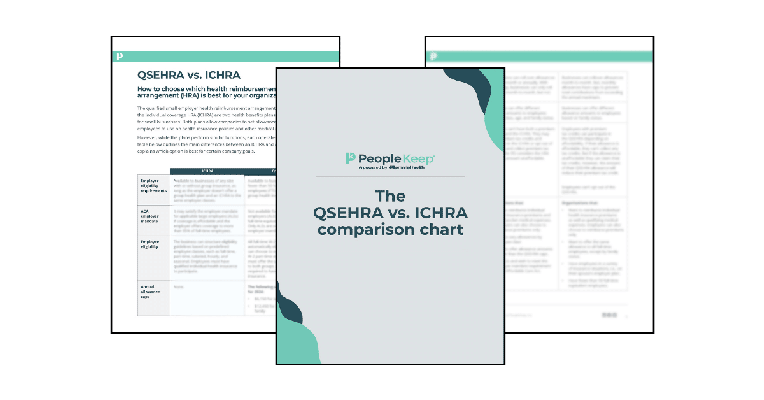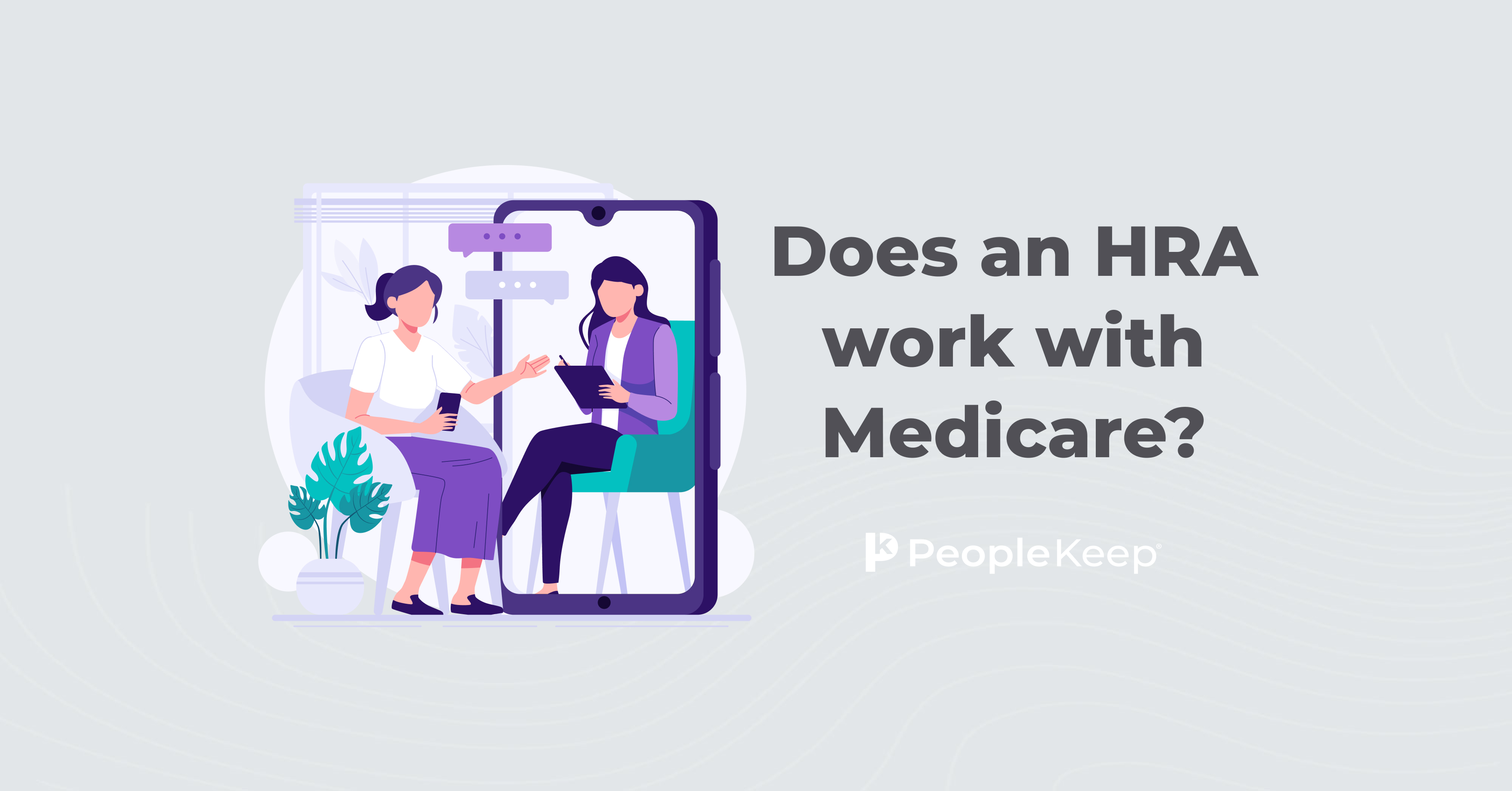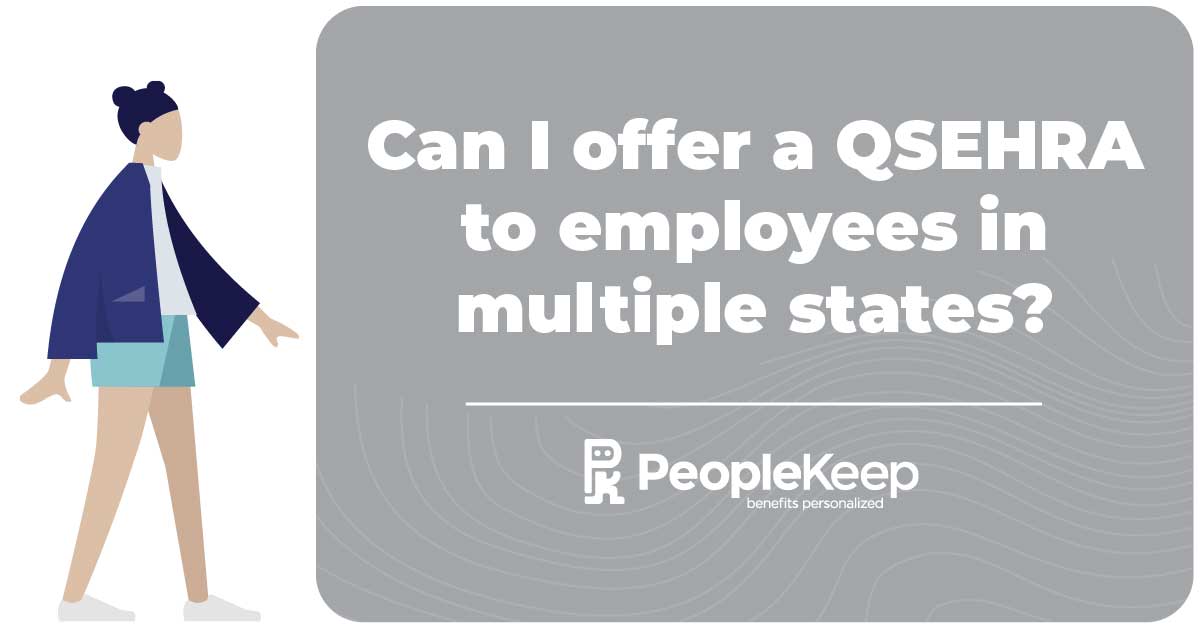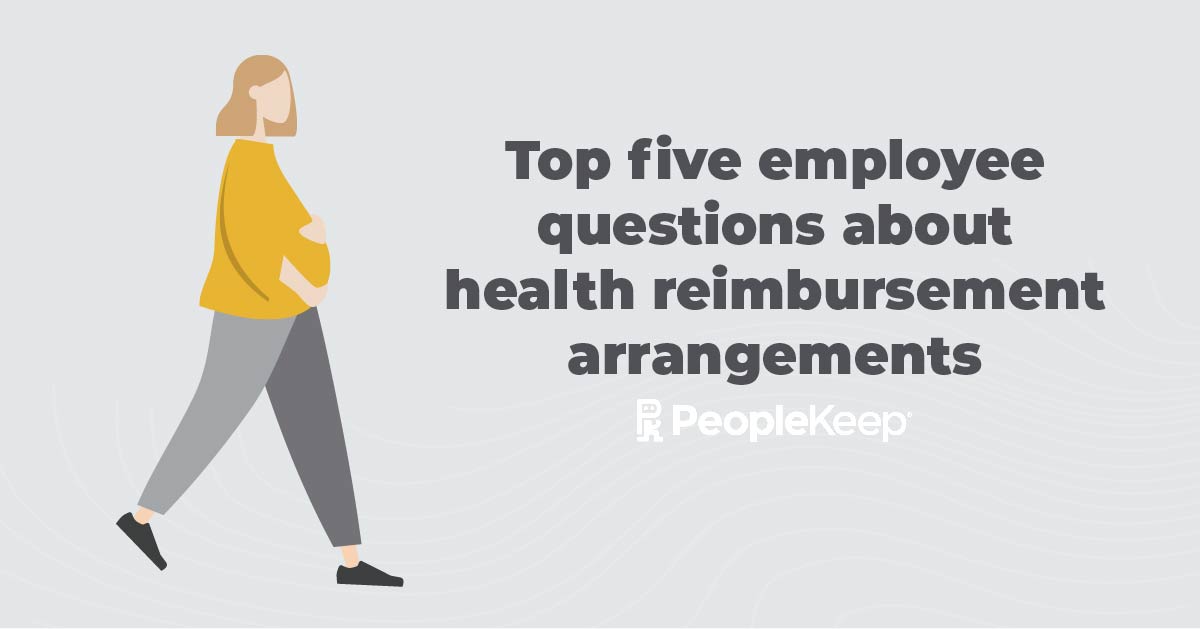Guide to the qualified small employer HRA (QSEHRA)
The qualified small employer health reimbursement arrangement (QSEHRA) is an alternative to group health insurance that makes offering a health benefit more accessible for small employers.
Considering a QSEHRA for your organization? See how PeopleKeep can help you launch this benefit by speaking with an HRA expert or downloading a demo of our software.

- Intro Introduction
- Chapter 1: What is a QSEHRA?
- Chapter 2: When was the QSEHRA created?
- Chapter 3: What are the benefits of a QSEHRA?
- Chapter 4: How does a QSEHRA work?
- Chapter 5: Who can offer a QSEHRA?
- Chapter 6: Which employees are eligible?
- Chapter 7: QSEHRA and premium tax credits
- Chapter 8: Can business owners participate?
- Chapter 9: How does a QSEHRA compare to other HRAs?
- Chapter 10: How PeopleKeep by Remodel Health can help
Looking for a budget-friendly way to offer benefits as a small business?
In a tight labor market, you need to go the extra mile to attract and retain employees. Otherwise, they’ll find better opportunities with your competitors. Health insurance remains the most in-demand employee benefit. However, the cost of healthcare is reaching unprecedented levels.
According to KFF1, annual employer-sponsored health insurance premiums averaged $8,951 for single coverage and $25,572 for family coverage in 2024. This is an increase of 6% and 7% respectively, since 2022. Family coverage premiums have increased 24% since 2018. Of this, employers typically cover 71-83% of the premiums.
This creates a significant barrier for small businesses and nonprofits looking to offer health benefits to their teams. So, how do you choose between recruiting and keeping top talent and staying within your budget? With a qualified small employer HRA (QSEHRA), you don’t have to.
This guide will cover everything you need to know about offering a QSEHRA.
What is a QSEHRA?
A qualified small employer HRA (QSEHRA), also known as the small business HRA, is a formal employer-funded health benefit. It allows organizations with fewer than 50 full-time equivalent employees (FTEs) to reimburse their employees tax-free for their individual health insurance premiums and other qualifying medical expenses.
Using a QSEHRA instead of a traditional group health plan allows you to avoid budget surprises and annual rate increases by setting an allowance for your employees. It also allows you to skip the complicated quoting process and minimum participation requirements of a traditional group health plan.
A QSEHRA benefits your workers, too. Instead of choosing a one-size-fits-all health policy that hopefully fits the needs of most of your workers, a QSEHRA allows your employees to choose the health policy that works best for them. This gives them more choice over their doctors, coverage, and premiums.
With a QSEHRA, you can offer a flexible health benefit at an affordable price while empowering your employees to take control of their healthcare.
When was the QSEHRA created?
In 2013, IRS Notice 2013-54 limited organizations’ ability to offer HRAs. The notice, which provided further guidance on the Affordable Care Act (ACA), essentially prevented HRAs from integrating with nongroup health insurance except in limited circumstances.
Congress created the QSEHRA with the 21st Century Cures Act on December 13, 2016, to provide some relief to small businesses. With a QSEHRA, small employers with fewer than 50 FTEs could once again offer an HRA for individual health insurance instead of a group medical plan.
December 13, 2016
Former President Barack Obama signed the 21st Century Cures Act into law, creating the QSEHRA.
What are the benefits of a QSEHRA?
There are many benefits to a QSEHRA for employers and employees. This includes empowering workers to control their healthcare, tax advantages, budget control, and no minimum participation or contribution requirements.
Empower employees to get the coverage and medical services that work best for them
When you offer a QSEHRA, your employees have the freedom to choose any ACA-compliant individual insurance plan instead of being stuck with a group plan that may not meet their needs.
You can also reimburse your staff with existing coverage through a spouse or parent for their qualifying out-of-pocket medical expenses listed in IRS Publication 502.
You can also enable employer-sponsored premium reimbursement (ESPR), which allows you to reimburse employees for premiums paid toward a spouse’s employer-provided health coverage. But, these reimbursements will likely be taxable income if the spouse already pays their premiums pre-tax through payroll deductions.
Tax-free reimbursements
All QSEHRA reimbursements for qualifying expenses are free of payroll taxes for the organization and its employees. Reimbursements are also free of income tax for eligible employees. These tax-free reimbursements mean you don’t need to report QSEHRA allowances as taxable income on their W-2s. Instead, you enter them as a tax-free amount.
No minimum contribution requirements or participation limits
Unlike traditional benefits, the QSEHRA has no minimum contribution limits, so you can offer the benefit to your employees even with a small budget. Instead, the IRS caps maximum annual contributions. For 2026, small businesses may offer up to $6,450 to self-only employees and up to $13,100 to employees with families.
| Year | Maximum allowance for single employees | Maximum allowance for employees with families |
| 2026 |
Maximum annual allowance: $6,450 Monthly allowance: $537.50 |
Maximum annual allowance: $13,100 Monthly allowance: $1,091.66 |
| 2025 |
Maximum annual allowance: $6,350 Monthly allowance: $529.16 |
Maximum annual allowance: $12,800 Monthly allowance: $1,066.66 |
| 2024 |
Maximum annual allowance: $6,150 Monthly allowance: $512.50 |
Maximum annual allowance: $12,450 Monthly allowance: $1,037.50 |
| 2023 |
Maximum annual allowance: $5,850 Monthly allowance: $487.50 |
Maximum annual allowance: $11,800 Monthly allowance: $983.33 |
| 2022 |
Maximum annual allowance: $5,450 Monthly allowance: $454.17 |
Maximum annual allowance: $11,050 Monthly allowance: $920.83 |
| 2021 |
Maximum annual allowance: $5,300 Monthly allowance: $441.67 |
Maximum annual allowance: $10,700 Monthly allowance: $891.67 |
| 2020 |
Maximum annual allowance: $5,250 Monthly allowance: $437.50 |
Maximum annual allowance: $10,600 Monthly allowance: $883.33 |
| 2019 |
Maximum annual allowance: $5,150 Monthly allowance: $429 |
Maximum annual allowance: $10,450 Monthly allowance: $870 |
Employer-sponsored group health insurance often comes with minimum participation requirements. Generally, insurers expect 70% of your eligible employees to enroll in the benefit. This means many small organizations with employees who opt out of the group plan because they already have coverage through a spouse or parent can’t offer the benefit. There are no minimum participation requirements with a QSEHRA. As long as you have at least one W-2 employee, you can offer a QSEHRA.
Control your budget with custom allowances
A QSEHRA enables employers to set monthly allowances, giving them complete control over their benefit costs. Once you set allowances for your workers, their expenses can’t exceed them. And because you don’t need to pre-fund HRAs, you only reimburse them when they make qualifying purchases. Any unused amounts at the end of the plan year remain with you.
How does a QSEHRA work?
With a QSEHRA, employers offer a tax-free monthly allowance to their employees for eligible medical expenses. Employees then purchase the healthcare services and items they want, including individual health insurance coverage, and the organization reimburses them up to their available allowance. QSEHRAs are employer-funded. There are no employee contributions.
If you’re new to offering a QSEHRA, we can help. At PeopleKeep, we’re experts on HRA administration and help thousands of employers reimburse their employees through our hassle-free QSEHRA administration software every day.
Regardless of how you choose to administer your QSEHRA, the following steps will apply.
Here’s a four-step breakdown of the process:
Step 1: Design your benefit to fit your needs
First, you design your QSEHRA benefit so it’s suited to the needs of your team and your budget. When setting up your QSEHRA, you’ll decide how much tax-free money you want to offer to employees each month for expense reimbursements. You can also decide whether you’d like to limit eligible expenses to premiums only or expand the benefit to cover all eligible expenses defined by the IRS in Publication 502.
You’ll also decide if you want to include your W-2 part-time employees. All full-time W-2 employees are automatically eligible. You can exclude seasonal employees, but if you choose to include them, you must offer them the same allowance as your full-time employees. You can also customize monthly allowances based on employee age and family status.
You can customize your QSEHRA allowances as follows:
- Offer everyone the same amount: This is the simplest way to establish a QSEHRA for your organization. Simply choose an allowance up to the IRS-established annual maximum.
- Offer everyone the maximum allowance for the year: You can give your employees the maximum the IRS allows for the year for single and family allowances.
- Vary allowances by family status: You can customize allowances based on your employees’ family statuses, such as single employees, single with dependents, married, and married with dependents.
- Vary allowances based on employee age: Employers can vary allowances by age, but the IRS requires a reference plan on the individual market. This is typically a 1:3 ratio between your youngest and oldest employees. If you offer a QSEHRA through PeopleKeep, we don’t support age-based allowances. You can accomplish this with an individual coverage HRA (ICHRA).
Once you design your benefit, you’ll need to create formal paperwork. The federal government requires formal plan documents. If you administer your QSEHRA with PeopleKeep, we generate these documents for you.
Step 2: Employees make healthcare purchases
Once you set your benefit up, eligible employees can use their own money to purchase individual health insurance coverage, copays, prescriptions, medical services, and healthcare items. This can include anything listed in IRS Publication 502.
If your employees don’t have health insurance with minimum essential coverage (MEC), they can enroll during the annual open enrollment period or during a 60-day special enrollment period (SEP) after you offer the benefit for the first time.
Step 3: Employees submit proof of incurred expenses
After incurring an expense, eligible employees can request reimbursement. They’ll need to submit documentation showing proof of purchase.
IRS regulations require the following information for you to reimburse your employees:
- The name of the item or service
- The cost of the item or service
- The name of the vendor or service provider
- The date of purchase
- If a service, documentation must include the date of the procedure or service
Invoices, receipts, or an explanation of benefits from an insurance company or healthcare provider typically satisfy the IRS requirements. Regulations may require a doctor’s note or prescription depending on the items your employees want you to reimburse. Keep in mind that this information is subject to HIPAA privacy rules. You must handle this information carefully if you’re self-administering a QSEHRA.
Employees must also provide proof of coverage (MEC) to establish their eligibility for their first reimbursement of the plan year. They must attest that they have qualifying health coverage with MEC every time they submit a reimbursement request. According to IRS Notice 2017-67, eligible employers can rely on these attestations as evidence of MEC unless they know an employee doesn’t have MEC. Your employees must have MEC for you to reimburse them income tax-free.
Step 4: Review and reimburse expenses
Finally, you’ll review the expense and either approve or reject the request based on IRS regulations and your plan design. If you’re offering a QSEHRA with PeopleKeep, our experts will review your employees’ submissions for you so you can be sure they qualify. Once we verify the submitted expenses, you can reimburse them up to their available allowance amount.
Employers typically reimburse their employees through payroll by adding a non-taxable line item to their paychecks. But you can also pay out QSEHRA reimbursements with a separate check, cash, or bank transfer.
Who can offer a QSEHRA?
Organizations with fewer than 50 FTEs) can offer a QSEHRA. You must have at least one W-2 employee (independent contractors and international workers aren’t eligible for a QSEHRA) and offer the benefit to all full-time employees at your organization. You also can’t offer a QSEHRA alongside any group plan, including dental or vision plans.
Employers interested in a QSEHRA that currently offer a group health insurance policy can cancel it and become eligible.
If you have 50 or more FTEs, you qualify as an applicable large employer (ALE). Due to the employer mandate, you must offer a health insurance plan to at least 95% of your full-time employees. While you can’t offer a QSEHRA, you can offer an individual coverage HRA (ICHRA), which works similarly. An ICHRA allows you to reimburse employees for their individual qualified health plans and other expenses.
Learn how a QSEHRA and an ICHRA compare
Download our free comparison chart.

Which employees are eligible to participate in a QSEHRA?
All W-2 full-time employees, their spouses, and legal dependents are automatically eligible to participate in the QSEHRA and can’t opt out. The employer can choose to include part-time workers in the benefit as well, but they must offer part-timers the same monthly allowance as full-time employees.
Employees covered under a spouse’s or parent’s group policy can still use QSEHRA funds toward their deductible, copays, and other out-of-pocket expenses. Employees must have insurance with minimum essential coverage (MEC) to participate.
QSEHRA and premium tax credits
The QSEHRA also has premium tax credit restrictions. Employees eligible for a QSEHRA can collect premium tax credits only if their QSEHRA allowance isn't considered affordable.
If the employee's cost for the second-lowest-cost silver plan on the marketplace is less than 9.02% of their household income for 2025 (9.96% for 2026) after the QSEHRA allowance, the QSEHRA is affordable, and the employee isn't eligible for their premium tax credits for the month. If the employee's cost is more than that percentage after their QSEHRA allowance, the QSEHRA isn't affordable, and the employee can collect their premium tax credits. However, they must reduce their tax credit by the amount of their QSEHRA allowance.
For example, suppose you offer a $300 monthly QSEHRA allowance to an employee who receives $400 each month in premium tax credits. If their allowance isn't affordable, they must subtract their $300 monthly allowance from their tax credit. This gives them $100 in tax credits that they can collect.
Learn more with our guide to calculating your premium tax credit with a QSEHRA
Can business owners participate in a QSEHRA?
Some types of business owners can’t participate in their organization’s QSEHRA. Let’s review each type of business owner below.
Can S-corporation owners participate in a QSEHRA?
IRS regulations dictate that S-corporation owners, their spouses, and their dependents who own more than 2% of the business can’t participate in a QSEHRA. This is because owners can write off their medical expenses through other means. The IRS also doesn’t consider S-corp shareholders as employees. Fortunately, this rule only applies to owners, and employees can still participate.
Can C-corporation owners participate in a QSEHRA?
C-corporations are legal entities separate from the owner. This means the IRS considers owners common-law employees of the corporation. C-corp owners can participate in a QSEHRA. As with all employees, this eligibility extends to the C-corp owner’s family as well. All reimbursements paid to the C-corp owner and the owner’s family are tax-free to the company and the owner as long as they have MEC.
Can sole proprietors participate in a QSEHRA?
A sole proprietorship is an unincorporated business owned and run by one person. There’s no distinction between the business and the owner, so the owner isn’t an employee. This means sole proprietors can’t participate.
If the owner is married to a W-2 employee of the business, the owner could gain access through their spouse’s allowance as a dependent. All reimbursements would be tax-free to the sole proprietorship and the owner’s spouse as long as they have MEC.
Can partners participate in a QSEHRA?
A partnership is a pass-through entity, meaning the company isn’t subject to income tax. Instead, the partners are directly taxed individually. Partners in a partnership are self-employed rather than company employees, so they’re not eligible to participate in a QSEHRA.
Similar to sole proprietors, partners can access the benefit if they’re married to a W-2 employee of the business, as long as the partner’s spouse isn’t also a business partner.
How does a QSEHRA compare to other HRAs?
The QSEHRA isn’t the only type of HRA available. While a QSEHRA works similarly to other types of HRAs, there are some differences. For example, an individual coverage HRA (ICHRA) allows for greater flexibility than a QSEHRA because employers can differ allowances and eligibility with 11 employee classes, and ICHRAs have no maximum contribution limits.
Both QSEHRAs and ICHRAs differ from the integrated HRA, known as a group coverage HRA (GCHRA), in that employers don’t have to offer a group health insurance to offer the benefit. Employers with traditional group health insurance plans can use a GCHRA to supplement their benefits by reimbursing employees for out-of-pocket medical expenses.
Here’s a chart to help you compare three of the most popular types of HRAs.
|
QSEHRA |
ICHRA |
GCHRA |
|
|
Business size restrictions |
The QSEHRA is only available to organizations with fewer than 50 FTEs. |
None. |
None. |
|
Employee eligibility requirements |
All full-time employees are automatically eligible. You can include part-time employees, but you must offer the HRA on the same terms. Employees can participate in the HRA without individual health insurance coverage. Those without minimum essential coverage (MEC) must pay income tax on all reimbursements during the time they were uninsured. Employers report any reimbursements for employees without MEC as taxable income on their W-2s. |
The organization can set eligibility guidelines according to permitted classes of employees, but employers must offer the HRA on the same terms to all employees in each class. Employees without individual health coverage, including those covered by a spouse's group policy, cannot participate in the HRA. |
Eligible employees must be covered by the business's group health insurance policy. |
|
Allowance amount restrictions |
Annual allowance amounts are capped for self-only employees and for employees with a family ( allowances caps are updated annually). The organization can vary allowance amounts only by family status, age, and family size, but not based on classes. |
There are no caps on annual allowance amounts. The organization can vary allowance amounts according to permitted employee classes as well as age and family status. |
There are no caps on annual allowance amounts. |
|
Group policy requirements |
Employers offering the HRA can’t offer a group policy. |
Employers offering the HRA may offer a group policy, but they can’t offer both the group policy and the HRA to the same employee class. |
Employers offering the HRA must offer a group policy. |
|
Premium tax credit coordination |
Individuals participating in the HRA are still eligible for premium tax credits for the month if their QSEHRA allowance is unaffordable. Participants must reduce the amount of the credit dollar-for-dollar by the amount of the HRA allowance for the month. |
Individuals participating in the HRA aren't eligible for premium tax credits. |
N/A |
|
Eligible expenses |
Individual insurance plan premiums and out-of-pocket costs listed in IRS Publication 502. |
Individual insurance plan premiums and out-of-pocket costs listed in IRS Publication 502. |
Out-of-pocket healthcare costs listed in IRS Publication 502. A GCHRA can’t reimburse premiums. |
Not sure which HRA is right for your organization? Take our quiz to find out!
How PeopleKeep by Remodel Health can help
When offering a health benefit to your staff, it may be a good idea to look beyond traditional employer-sponsored group plans. A QSEHRA is a company-funded health benefit for small employers that offers more flexibility and budget control than a group plan. It also empowers employers to request reimbursement for the healthcare services and coverage that works best for them.
If you want to offer a QSEHRA to your employees, PeopleKeep can help!
At PeopleKeep, we offer benefits administration software for:
Our HRA administration software makes it easy to set up and manage your benefit in minutes each month. We can help you ensure compliance with your QSEHRA by reviewing your employees’ reimbursement requests, generating required plan documents, and storing your documents.
What makes a QSEHRA with PeopleKeep different?
PeopleKeep’s QSEHRA administration software makes offering a health benefit possible for small employers—regardless of where they are on their benefits journey. Learn how we can help you better care for your team by scheduling a live demo or downloading a video walkthrough of our software.

QSEHRA frequently asked questions
A QSEHRA is a company-funded health benefit for small businesses and nonprofits with fewer than 50 full-time equivalent employees (FTEs). It allows organizations to reimburse their employees tax-free for medical expenses. It's an excellent first-time benefit or alternative to traditional group health plans.
Organizations don’t need any special enrollment periods to sign up for a QSEHRA—employers can enroll at any point during the year. In addition, offering your employees a QSEHRA qualifies them for a 60-day special enrollment period to shop for an individual health insurance policy on the individual market outside of the annual open enrollment period.
If your employees need individual or family coverage with MEC, they can explore their options on the federal Health Insurance Marketplace or state-based exchanges. These public exchanges allow them to compare ACA-compliant health, dental, and vision plans. Offering a QSEHRA for the first time creates a 60-day special enrollment period where they can enroll in coverage. Otherwise, they can always enroll during the annual open enrollment period.
IRS Publication 502 lists the eligible items you can reimburse employees for. This includes doctor visits, copays, individual insurance premiums, prescription glasses, prescriptions, and even LASIK eye surgery. You can always exclude certain categories or reimburse premiums only as long as you apply these rules to all employees.
Under IRS rules, employers can legally allow for unused amounts of a QSEHRA allowance to roll over from month-to-month and year-to-year. However, if you’re offering a QSEHRA with PeopleKeep, only month-to-month carryover amounts are permitted.
While the QSEHRA is an excellent option for small businesses, it may only meet the needs of some organizations. Potential downsides are the maximum contribution limit, no employee class options, and having to coordinate with premium tax credits.
Yes, employer contributions (allowances) are tax-free for the employer and eligible employees.
Contributors:

Chase Charaba
Content Marketing Manager
Sources:
Downloadable resources
Additional QSEHRA resources

Does an HRA work with Medicare?

Can I offer a QSEHRA to employees in different states?

2026 QSEHRA contribution limits

Should I still offer the QSEHRA when group insurance is cheaper than individual?

Health insurance reimbursements: What are the options?

HRA FAQs for employees

Small business health insurance costs: What can you expect?

Special enrollment periods (SEPs) and the QSEHRA



